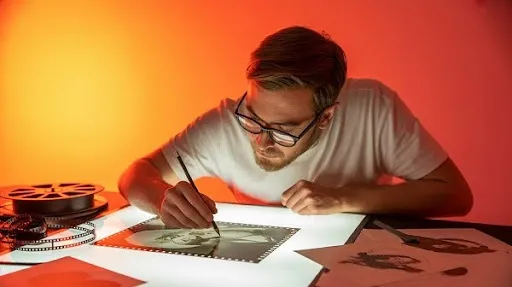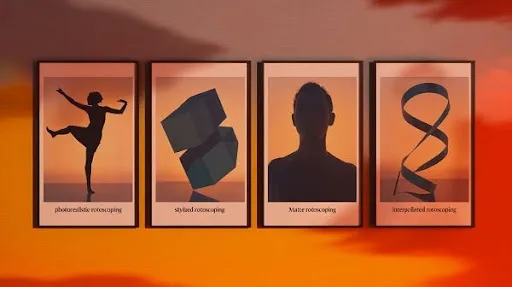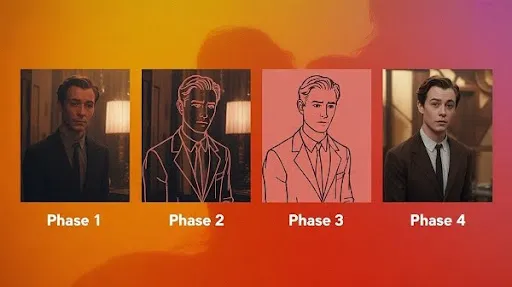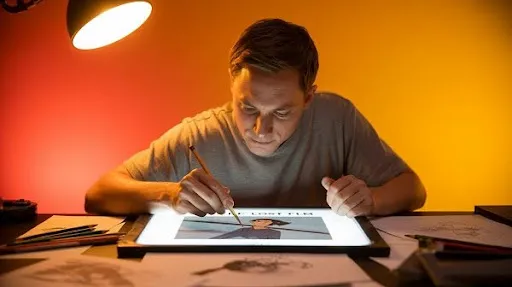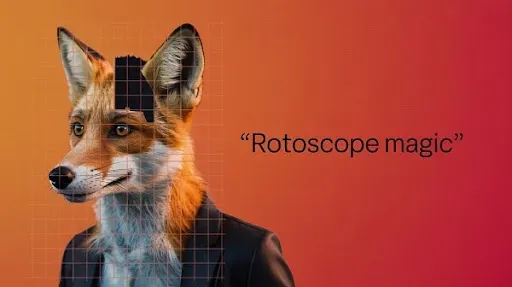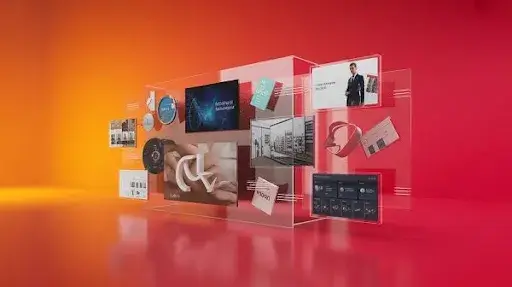The very first encounter with rotoscope animation can evoke a sense of strangeness and wonder, for it is simultaneously recognizable and foreign. Its duality of two worlds intertwining together: artistry and realism, is one that has been shaping animation for over a century.
This technique has been a force alongside the black-and-white animation, giving on-screen movement a sense of stylization, realism, and even surrealism depending on the creator’s vision.
The animation market is stable than ever right now with a compound annual growth rate (CAGR) at above 6% through 2028.
This is not some passing animation gimmick. Despite the shadow of CGI, rotoscope animation technique possesses a precise process of rotoscoping, a deep history, and a blend of creative avenues that render it pertinent today.
What Is Rotoscope Animation?
To begin, rotoscope animation is an animation technique as old as the technique itself, where artists trace live-action footage frame by frame. Motion can be exaggerated or altered in an entire different way.
Originally, this wasn’t a digital trick. Flexibility in today’s productions is limitless, for earlier animators used to painstakingly project copied footage on glass and trace it by hand.
Now, advanced rotoscope animation software makes these processes simpler, though the basic rotoscoping technique of the craft remains constant.
In the case of live-action films, rotoscoping can blend seamlessly with the filmed footage. Rotoscoping is used to remove elements and/or create visual effects. Who would forget the lightsabers in Star Wars? That glow came to life through this technique. Wire removal in Mary Poppins? Also rotoscoping.
The History Behind Rotoscoping
In 1915, rotoscoping was first used by Max Fleischer, an animator who strived for realistic movement in his characters. He shot a live-action film, used a projector, and traced frame by frame.
His first major work where he used this technique was bringing Koko the Clown to life, which he performed in front of audiences. He had used animation to bring characters to life, which was a huge advancement in the tech world.
Fleischer patented the process, and for a long time, his studio, which was famous for Betty Boop, Popeye, and even the original Superman cartoons, had rotoscope animation rights. Other studios didn’t rotoscope spoilers until 1934. After that, Disney began to use rotoscoping in huge films such as Snow White and the Seven Dwarfs, Pinocchio, and Alice in Wonderland.
Transformative film actors are to be used as live reference, and after capturing, animated characters could be drawn with realistic movements, gestures, and even facial expressions.
By the mid-20th century, rotoscoping had moved beyond animation. Alfred Hitchcock used it in The Birds to composite attacking bird scenes. The Beatles’ Yellow Submarine and Ralph Bakshi’s The Lord of the Rings adapted it for psychedelic and fantasy visuals.
The Basic Principles of Rotoscoping
No matter how much technology has changed, the basic principles of rotoscoping have stayed consistent:
- Source Footage – A live-action recording serves as the foundation.
- Tracing or Masking – Each frame is manually outlined or digitally masked.
- Frame-by-Frame Consistency – Artists maintain smooth, believable motion by carefully adjusting outlines for every frame.
- Stylization or Integration – The traced sequence is either stylized for animation or integrated into live-action effects.
All of this may appear simple, but it is actually very time-consuming, and to ensure that every small detail is accurate, it requires a great level of attention. One mistake can break the illusion of movement.
Different Types of Rotoscoping Animation
Depending on the objective, there are different types of rotoscoping animation to get the desired outcome.
- Photorealistic Rotoscoping – Maintains real-world proportions and motion; often used in films that aim for realism.
- Stylized Rotoscoping – Imposing painterly effects or heavy outlines is one of the effects that rotoscoping animation applies to realistic movements.
- Matte Rotoscoping – They allow visual effects to separate elements within a scene, erase backgrounds, or merge several layers.
- Interpolated Rotoscoping – An animation technique focusing on actions. It uses an automated tool to fill in the gaps between specified keyframes, minimizing manual tracing work.
The Role of Interpolated Rotoscoping
In the early ’90s, animator Bob Sabiston pioneered interpolated rotoscoping, a computer-assisted method that sped up production without sacrificing style. His custom program, Rotoshop, allowed animators to trace a figure for a few frames, then have the software interpolate (or “in-between”) the movement for the rest.
Films like Waking Life and A Scanner Darkly would not have been feasible to produce without this development. A blend of human creativity alongside automated help achieved the flowing and dreamlike look of the visuals.
While Rotoshop itself is proprietary, other rotoscope animation software options have emerged to replicate similar functionality for filmmakers and animators.
The Process of Rotoscoping
The process of rotoscoping has several stages. Here’s how professionals typically handle it today:
- Select the Footage
Choose high-quality reference material. For animation, this often means actors performing scenes. For VFX, it could be any live-action shot needing modification.
- Import into Software
Load the footage into a digital compositing tool or specialized rotoscoping program.
- Create Mattes or Masks
Outline the elements you want to isolate, remove, or trace over. This might be a character, an object, or even just a section of the frame.
- Trace Frame-by-Frame
Adjust outlines for every frame to match motion precisely. Even with automation, manual correction is almost always needed.
- Stylize or Composite
For animation, apply artistic styles, colors, and textures. For VFX, integrate the masked element into the desired background or effect.
- Review and Refine
Watch the sequence in motion to catch inconsistencies or jittery outlines.
Significance of Rotoscoping Today
It might seem old-fashioned in the age of motion capture and 3D modeling, but rotoscoping’s strengths are unique. It gives animators absolute control over style and detail, frame by frame. Additionally, it applies to footage that cannot be lost digitally, such as performances that took place in the world or archival footage.
In visual effects, it is still fundamentally important in shot compositing, cleanup, and the merging of practical effects with CGI done during cleanup.
More recent examples include Guardians of the Galaxy, where rotoscoping to animate characters was done through studying real-life creatures. Raccoons, for example, were based on a real raccoon named Oreo. This mixture of stylization and reality maintains audience engagement with the believability of the characters.
The Rotoscoping Animation World in Pop Culture
Over the years, the rotoscoping animation world has delivered some unforgettable sequences:
- Snow White and the Seven Dwarfs (1937) – Disney’s first feature-length film using extensive live-action tracing.
- Mary Poppins (1964) – Wire removal and animation integration.
- Yellow Submarine (1968) – Psychedelic animation layered over realistic motion.
- The Lord of the Rings (1978) – A fantasy epic using rotoscoped battle scenes.
- Waking Life (2001) – Experimental, philosophical storytelling with interpolated rotoscoping.
- A Scanner Darkly (2006) – Surreal, paranoia-laced visuals perfectly matched to the story’s tone.
Pioneered Photorealistic Rotoscoping in VFX
When it comes to visual effects, pioneered photorealistic rotoscoping changed the game. Before the introduction of green screens, artists would combine elements within a shot and rely on hand-drawn mattes to merge various components. This painstaking technique is what gave many films their convincing look, as it did not rely on digital shortcuts.
Even today, high-end productions still rely on this technique to polish specific sequences, particularly when lighting, set designs, or costumes make automated keying impossible.
Modern Rotoscope Animation Software
Digital tools have redefined how the process of rotoscoping is done. While the artistry remains, software has taken over the heavy lifting of frame management, masking, and interpolation.
Some popular tools include:
- Adobe After Effects – Standard in the industry for motion graphics and VFX, the software and tools come with an advanced feature for quick isolation with the Roto Brush tool.
- SilhouetteFX – Used in high-end productions for precision work and detailed matte creation.
- Nuke – A staple in professional VFX pipelines, offering advanced rotoscoping and compositing tools.
- Mocha Pro – Known for planar tracking that makes rotoscoping more accurate and less labor-intensive.
While Bob Sabiston’s Rotoshop still has not opened to the public, this software and these tools provide similarly results. The rotoscope animation software enhances the skill of the artist, and does not replace it. Decisions need to be made on precise outlines, adjustments, and details for the movement and stylization.
Learning the Technique of Rotoscoping
The technique of rotoscoping captures the movement in angles with particular attention to their seamless blending alongside shapes.
Often, outlines may appear to be “jitter” due to adjustments made with outlines proportionate to motion.
Practical tips for learning include:
- Start with short clips — avoid overwhelming yourself with long sequences early on.
- Focus on clean edges — sloppy masks stand out immediately.
- Study real movement — notice how limbs, hair, or clothing behave in motion.
- Use software shortcuts — but never rely on them entirely.
The more you practice, the more instinctive these adjustments become.
Creative Uses Beyond Film
Besides the film and TV industry, the rotoscoping animation world has branched into advertisement, music videos, educational videos, and even interactive animation.
- Advertising – Brands use stylized rotoscoped footage to stand out from typical live-action commercials.
- Music Videos – Visual amazement has always been associated with the animation performed by artists such as A-ha and Kanye West in their songs.
- Educational Media – Rotoscoping helps illustrate real-world demonstrations while adding emphasis or clarity.
- Social Media Content – Short, stylized animations grab attention in crowded feeds.
Its flexibility makes it a powerful creative tool for any visual medium.
Different Challenges in Rotoscoping
Rotoscoping requires artistic skills and a proactive approach for problem-solving some common challenges, which include:
- Complex Movement – Hair, fur, and flowing fabric require extra attention to maintain realism.
- Lighting Changes – Shifting shadows can make outlines harder to track.
- Multiple Overlapping Subjects – When subjects cross in front of each other, separating them cleanly takes precision.
- Long Sequences – Even with software, long sequences can test patience and focus.
Overcoming these requires both technical skill and artistic judgment — knowing when to spend extra time refining a section versus when to keep things moving.
Basic Rotoscoping Technique vs. Automated Tools
There is a trend around the use of automation in animation and VFX centers. There is no question that the basic rotoscoping technique still holds invaluable worth. Alongside the speed at which AI-assisted tools create works of automation, there is always room for gaps and mistakes in fine details, which require refinement.
Photographers operate at a higher level than an individual who relies purely on auto-focus. They understand the difference a manual setting can provide in capturing that perfect photo.
How Rotoscoping Helps Animate Characters
Exaggeration and realism blend perfectly through the application of rotoscoping to animate characters. For example:
- The aesthetic of a comic book can stylize the initial stunt performance of the rotoscoped superhero fight scenes.
- An animal character can fit into a fanciful world while still mimicking the neurotic habits of a reference animal.
- Human performances can be preserved in full detail, even if the final design is entirely fictional.
The rotoscoping animation world is highly likely to flourish alongside the evolution of storytelling mediums.
The Future of Rotoscoping Animation
The demand for animated, yet realistic, motion in virtual and augmented realities, alongside interactive games, is increasing.
While rotoscoping automation might replace some of the mundane tasks, the overall workload is more likely to remain the same. Automation is a solution for tedious tasks, while human workers apply imagination and thoughtful decisions to the work.
Frequently Asked Questions
What is rotoscope animation used for today?
For merging live footage with animated sequences, isolating objects in video effects for cleanup and enhancement, and also to remove or replace unwanted objects while adding real-time effects, Automation is a solution for tedious tasks, while human workers apply imagination and thoughtful decisions to the work.
Is rotoscoping the same as tracing?
Not exactly. Tracing is a basic artistic practice, but rotoscoping is a specialized form of tracing that aligns precisely with motion frame-by-frame for film or animation.
How long does rotoscoping take?
Although video is a highly detailed creative work, the automation of tools generally follows the fastest methods possible. In fact, the rotoscoping process is highly automated. Yet, automation of processes is greatly beneficial.
What skills do you need for rotoscoping?
Attention to detail, patience, understanding of movement, and proficiency with rotoscope animation software.
What is interpolated rotoscoping?
It’s a semi-automated method that uses software to fill in movement between traced frames, reducing the amount of manual work.
Are there different types of rotoscoping?
Yes — including photorealistic, stylized, matte rotoscoping, and interpolated approaches.
Why Rotoscoping Is Still Worth Learning
Even with AI animation and 3D motion capture, learning the technique of rotoscoping gives creators a unique advantage. It’s a skill that’s as relevant for indie animators as it is for big-budget studios.
Studios need professionals who can blend live-action and animated elements seamlessly — a role that’s not disappearing any time soon.
Final Word
In the right hands, rotoscope animation is more than a technical step in production. It’s a way to merge reality and imagination without losing the authenticity of human movement. From the history behind rotoscoping to the advanced rotoscope animation software used today, the technique has proven it can adapt and stay essential.
For creators, the most important aspect is to know the process of rotoscoping, and how animation and VFX storytelling can sharpen the narrative and enrich unconventionally believable visuals to the audience to appeal, and to tell visually enchanting stories in a creative a believable, uncanny way, to immerse the audience and suspend disbelief.
If you’re ready to explore this craft for your project, Prolific Studio, one of the best animation companies in Washington, DC, can help. Our team blends artistry with technical expertise, bringing the basic principles of rotoscoping into every frame we touch. The result? Animation and effects that don’t just look good — they feel alive.
Related articles:

